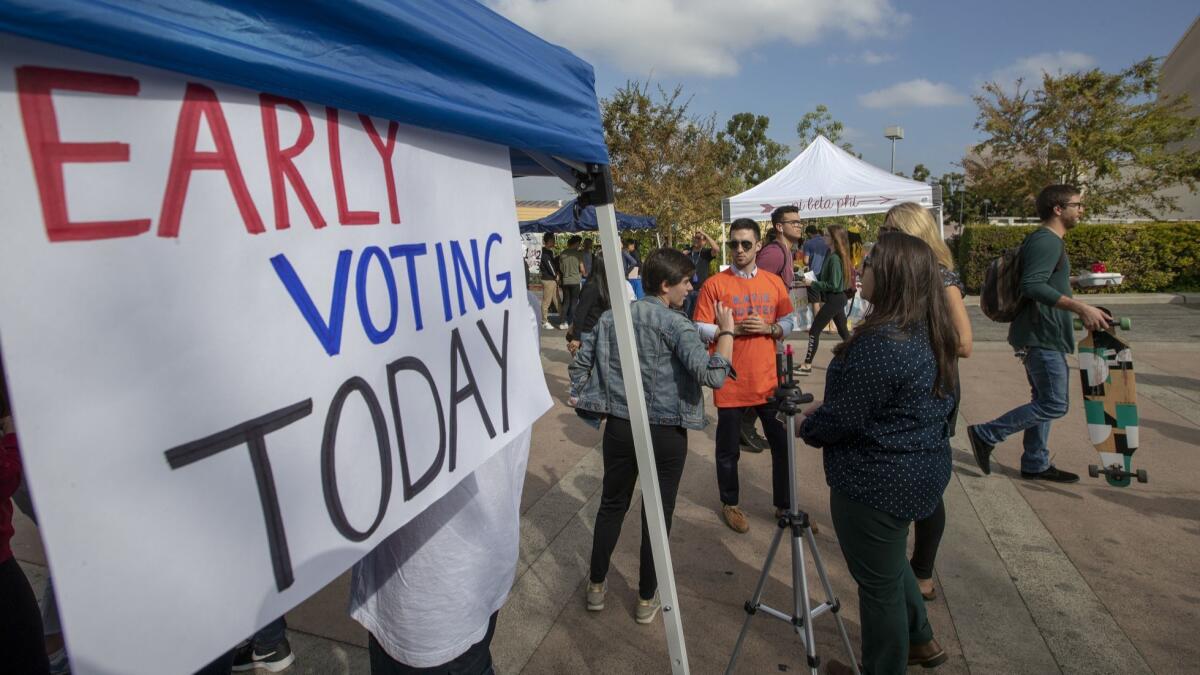Column: Is California’s new voting system a success? We may not know until 2020

- Share via
California lawmakers had high hopes when they enacted a sweeping new election system in 2016. They pledged it would result in higher turnout, lower costs and a better overall experience for voters.
Three years later, it’s difficult to discern whether the California Voter’s Choice Act has delivered on those promises. And the stakes have never been higher, as counties that represent almost half of the state’s registered voters are preparing to switch to the setup for 2020.
The law was designed to provide a more flexible experience than what traditionally happens on election day. The most far-reaching change was the elimination of tens of thousands of neighborhood polling places, replaced by absentee ballots and secure drop boxes.
Multipurpose “vote centers” are open for several days before the election in the counties that chose to participate. There, voters can fill out a ballot or simply drop one off, update their registration or get a replacement ballot if they’ve lost the original.
The system is optional — thus keeping state government from having to pay for a new mandate imposed on California’s 58 counties. Fourteen counties were eligible to make the switch last year but only five took the plunge: Madera, Napa, Nevada, Sacramento and San Mateo.
A new study by some of the state’s most prominent election researchers found those counties had a modest boost in average voter turnout — 3% from the midterm election four years earlier — compared to communities that stuck to the traditional election model. Turnout seemed higher, too, among often underrepresented groups including young voters, Latinos and Asian Americans.
California’s electoral future is rooted in the old-fashioned absentee ballot »
The real test, though, will come in the state’s presidential primary next March. Ten counties — some with large electorates like Los Angeles, Orange and Santa Clara — will join the switch from election day polling places to multiday vote centers.
Special attention should be paid to Los Angeles County, which was given a one-time exemption in 2020 from having to mail a ballot to each of its 5.4 million voters. Many residents will have to seek out the county’s vote centers — not guaranteed to be as close as polling places once were — to cast a ballot. Getting the word out over the next few months will be crucial.
Researchers from USC and UC Riverside, in a summary of their study on how the new state law worked in 2018, found elections officials faced a number of unexpected hurdles with the Voter’s Choice Act.
Costs went up in some counties, as workers at vote centers needed additional training and counties replaced the often no-fee locations for polling places with buildings that had to be rented for a week or more. Some local officials said they needed more vote centers than the minimum required by the state law, especially on election day — for whatever reason, a number of voters didn’t use the service until the last minute.
“The culture of in-person voting on one single day will require more than one election cycle to change,” the researchers wrote.
Nor does success have a single definition. Some local officials say the new law’s impact should be measured by voter turnout. Others told researchers it’s about making elections more efficient. Many hope the vote centers — where registration problems can quickly be cleared up — will lower the use of provisional ballots, the fail-safe option designed for when poll workers can’t confirm a voter’s information. Vote centers have that information readily available.
In short, every county — perhaps every voter — will expect something different. And what happens in 2020 could be key to whether California is on the verge of a major transformation of its electoral democracy.
Follow @johnmyers on Twitter and sign up for our daily Essential Politics newsletter
More to Read
Get the L.A. Times Politics newsletter
Deeply reported insights into legislation, politics and policy from Sacramento, Washington and beyond. In your inbox three times per week.
You may occasionally receive promotional content from the Los Angeles Times.











